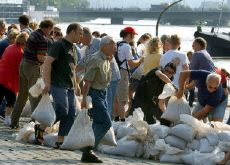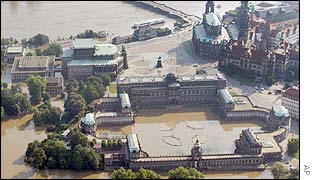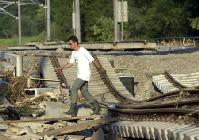(Clearwisdom.net)
A volunteer crosses the damaged railway track near the station in Tharandt, eastern Germany, Monday, Aug. 19, 2002. Several miles of new track, which ties the cities of Dresden, eastern Germany and Nuremberg, western Germany, opened last year, has been detroyed by the floods in the past days. Floods have wiped out or severely damaged scores of roads, rail lines, bridges, stores and private homes in Germany, Austria, the Czech Republic and Slovakia, leaving countries with a cleanup and rebuilding bill estimated at $20 billion. (AP Photo/Matthias Rietschel)

Volunteers fill sandbags to protect the town from flooding water of the swollen Elbe River. The floods of the Elbe River that devastated huge parts of Dresden and the German state of Saxony threaten the German states of Brandenburg and Saxony-Anhalt now. Across Europe the flood has killed at least 105 people.(AFP photo)

The Zwinger in Dresden, eastern Germany, is surrounded by floodwaters on Friday,
Aug. 16, 2002. The Elbe River - fed by high water that earlier devastated Prague - rose above nine
meters Friday, shattering the previous all-time high of 8.76 meters reached in 1845. Already, some
5,000 people have been forced to leave their homes in Dresden in recent days as Europe's flooding
hit east Germany. (AP Photo/Christof Stache)
The European flood continues to spread quickly with Germany being hit the hardest. The worst flood in last 150 years reached Dresden and posed serious threats to the historic city. Residents filled sandbags around the clock to protect the city and moved 6000 pieces of priceless art works to safety. River Elbe reached a record peak and submerged some historic sites. The flood caused 100, 000 people lose their homes.
The floodwater also threatened an important industrial town northwest of Dresden. Environmentalists worried that the flood could cause the factory to leak toxic chemical waste. A chemical factory in Brag had leaked chlorine. The cloud turned yellow and the River Elbe was also contaminated with chlorine.
Following is report from CNN.
Floods spark chemical spill fear
BITTERFELD, Germany (CNN) --Flood levels along Germany's River Elbe reached a peak on Saturday in the historic city of Dresden, and threatened to send water pouring into a chemical plant in a nearby town.
The centre of the town of Bitterfeld is already completely inundated with water filled with diesel fuel and oil, reaching as high as a metre in some areas, CNN's Gaven Morris reports.
Most of the 16,000 residents of Bitterfeld -- which is located on the Elbe's tributary, the Mulde River -- have been evacuated and authorities used megaphones on Saturday to tell remaining residents to leave.
Local officials are primarily concerned with one chemical plant, which is at risk if the dam bursts. That could send hazardous chemicals pouring into the surrounding areas.
Meanwhile, evacuations continued in towns and cities north of Dresden, where the floodwaters held steady on Saturday at 9.39 metres (about 31 feet).
In Torgau, about 100 kilometres (60 miles) northwest of Dresden, the water level was rising at about five centimetres per hour, flooding the dykes and prompting evacuations, according to Susanne Meves of the Saxony Crisis Centre.
She said thunderstorms threatened to dump rain on the flooded area.
In the region of Saxony, the eastern German state where Dresden is located, 108 people were injured and 27 were missing as a result of the floods, Meves said.
The churning waters of Elbe River, which empties into the North Sea in northern Germany, shattered a 157-year-old record in Dresden Friday afternoon at 9.3 metres (30.5 feet), the Dresden Emergency Centre said. The normal depth of the Elbe at Dresden is two metres (about 6.5 feet).
The river's previous record high mark was 8.76 metres (nearly 28.75 feet) set in 1845.
The high water in Dresden is part of flooding across six European countries that has killed around 100 people.
About 33,000 people have been forced to evacuate the rising waters in the city, according to the German Red Cross.
The floodwaters spread beyond Dresden's historic core on Friday, according to city officials, swamping a number of government buildings, including the offices of Saxony's economics ministry.
Also flooded were the Zwinger Palace, one of Europe's most important art museums, the Albertinum Museum and the Semper Opera House. Volunteers had moved thousands of pieces of art work from the basements and ground floors of the museums to higher levels.
The opera house, whose stage was once home to such luminaries as Carl Maria von Weber, Richard Wagner and Richard Strauss, stood in a lake.
Efforts to outrace the flood continued Friday at the National Archeological Museum, where Director Reiner Vollkommer, his staff and volunteers had been working nearly around the clock to remove treasures from the basement.
"It's a question of how long we can still do it, but we hope we can succeed," Vollkommer said. "We are very worried."
He said that as soon as water was pumped out one part of the building's basement, it would begin seeping into another part.
Police said that people in much of the historic area of the city had been evacuated, including guests in a number of riverside hotels.
Across Saxony, authorities estimate damage to be at least $1 billion. German Chancellor Gerhard Schroeder has promised $400 million in aid to flood-stricken parts of the country.
Dresden, which traces its origins back to the 1200s, has been a traditional cultural capital. It was the target of an allied bombing campaign in February 1945 during the final days of World War II that killed 35,000 people and destroyed much of the centre of the city.
Restoration of many of the historic buildings, such as the opera house, were not completed until the mid-1980s.
The famous Dresden china is manufactured in a suburb.
The Elbe River at Dresden was being fed in part by floodwater from the Vltava River, which earlier flooded the Czech capital of Prague.
That city's historic bridges survived the river's raging current, but the floodwater caused uncalculated damage to Prague's historic centre.
City officials said it will be difficult to estimate the cost of the damage until the water recedes completely -- at least another three days -- but indications show it will be at least 60 billion crowns ($2 billion).
Officials said some of the 200,000 Czechs evacuated along the river will be allowed to move back to their homes over the weekend, but others may have to wait for two weeks.
The Czech government is planning to launch an appeal for international bank loans and aid, including a request for money from the European Union, which the Czech Republic hopes to join.
The Czech Embassy in London told CNN that pumps, including suction and paddle types, will be needed as well as dehumidifiers to help in the clean up.
Zuzana Bluh, spokeswoman for the Czech Embassy in London, said flooded areas included the medieval town of Cesky Krumlov in southern Bohemia, and Cesky Krumlov, a UNESCO-designated world historical town known as the "Renaissance jewel." Damage may be extensive, she said.
Along with Germany and the Czech Republic, flooding has hit communities in Austria, Slovakia, Russia, and Romania.
In Slovakia, a state of emergency was announced in Bratislava as the Danube River rose. The flooding is being called the worst in a century in Austria, where thousands have been evacuated from the Salzburg and Upper Austria provinces.
In Russia, at least 58 people in the Black Sea region were killed by swiftly moving water late last week.
Category: April 25 Events






